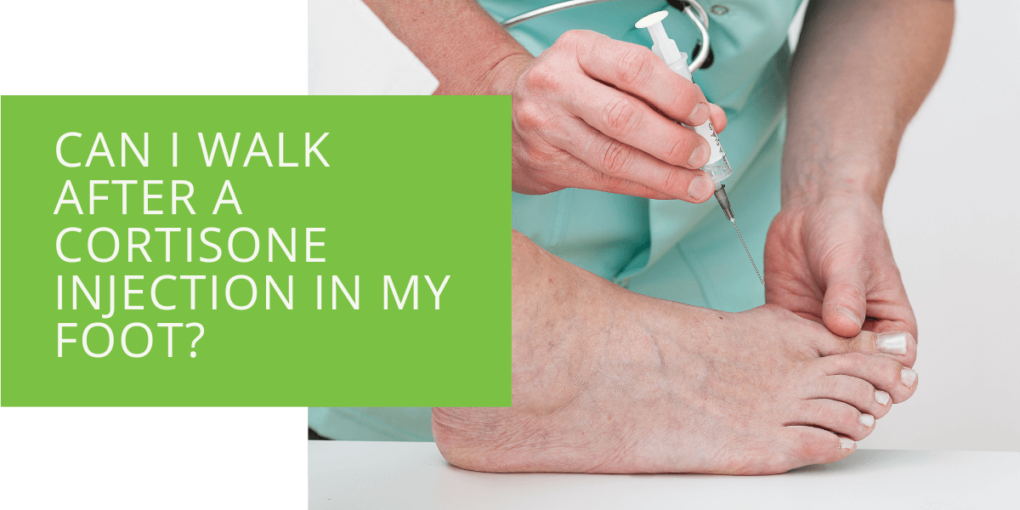Can I Walk After a Cortisone Injection in My Foot?
Cortisone or steroid injections are a common treatment for foot and ankle pain caused by inflammation or arthritis. Cortisone is a powerful anti-inflammatory medication injected directly into the affected area to relieve pain and reduce inflammation. If you're considering a cortisone injection in your foot, you may wonder if you can walk after the injection. This article will explore what to expect during and after a cortisone injection in your foot, potential side effects, and when to seek additional treatment.
What to Expect During a Cortisone Injection
During a cortisone injection, your podiatrist will use a needle to inject a corticosteroid medication and local anaesthetic into the affected area of your foot. The injection site may be numbed with a local anaesthetic to reduce pain and discomfort before the injection. The injection takes only a few minutes, and you can typically leave the office immediately after the procedure.
Walking After a Cortisone Injection in Your Foot
After a cortisone injection in your foot, you may be able to walk immediately. However, it's important to be mindful of your foot and avoid strenuous activity for a few days to allow the injection to take effect.
Walking Immediately After the Injection
You should be able to leave your podiatrist's office immediately after the injection. The injection site may be numbed with a local anaesthetic before the injection, so you may not feel much pain or discomfort during the procedure. However, you may feel some tenderness or stiffness in the affected area.
Rest and Avoiding Strenuous Activity
After the injection, it's important to rest and avoid strenuous activity for a few days to reduce the risk of further irritation or injury. Strenuous activities that stress the affected tendon or joint, such as running or jumping, should be avoided. You may be advised to take it easy for the first day or two after the injection and gradually increase your activity level as you feel comfortable.
Dealing with Discomfort
You may experience discomfort or stiffness in the affected area for a few days after the injection. This is normal and typically resolves on its own within a few days. Your podiatrist may recommend ice, over-the-counter pain medications, or other treatments to help manage any discomfort during the recovery period.
Shoes and Orthotics
It's important to wear comfortable, supportive shoes during recovery to reduce stress on the affected area. Your podiatrist may recommend specific shoes or orthotics to help support your foot and reduce the risk of further injury.

Recovery After a Cortisone Injection in Your Foot
After a cortisone injection in your foot, it's important to give your body time to heal and allow the injection to take effect. Here are some things to keep in mind during the recovery period:
Timeframe for Recovery
The cortisone injection may take a few days to take effect, and you may notice an increase in pain or discomfort for the first few days after the injection. However, this is normal and typically resolves independently within a few days. The injection may take up to a week or more to provide significant pain relief.
Following Your Podiatrist's Instructions
During the recovery period, it's important to follow your podiatrist's instructions and avoid strenuous activity to allow the injection to take effect. You should also keep the injection site clean and dry to reduce the risk of infection.
Managing Discomfort
If you experience discomfort during recovery, your podiatrist may recommend ice, over-the-counter pain medications, or other treatments to help manage your symptoms. It's important to avoid using heat on the affected area, as this can increase inflammation.
Potential Side Effects of a Cortisone Injection in Your Foot
Like any medical procedure, cortisone injections can have potential side effects. Some of the most common side effects include:
- Pain or discomfort at the injection site
- Swelling or bruising at the injection site
- A temporary increase in pain or stiffness after the injection
- Infection at the injection site (rare)
If you experience any of these side effects after a cortisone injection, it's important to contact your podiatrist for further evaluation and treatment.
When to Seek Additional Treatment
While cortisone injections can relieve pain and reduce inflammation, they may not be appropriate for everyone. If you're experiencing foot or ankle pain, it's important to see a podiatrist for an accurate diagnosis and treatment plan. Alternatively, alternative treatments such as physical therapy, orthotics, or other medications may be more appropriate for your needs.
It's also important to seek additional treatment if your pain or discomfort persists after a cortisone injection or if you experience any unexpected side effects. Your podiatrist can help you determine the best course of treatment for your individual needs.
Conclusion
Cortisone injections can effectively treat foot and ankle pain caused by inflammation or arthritis. While you should be able to walk immediately after a cortisone injection in your foot, it's important to follow your podiatrist's instructions and avoid strenuous activity during the recovery period. If you're experiencing foot or ankle pain, don't hesitate to contact a podiatrist for an evaluation and treatment plan tailored to your needs.

